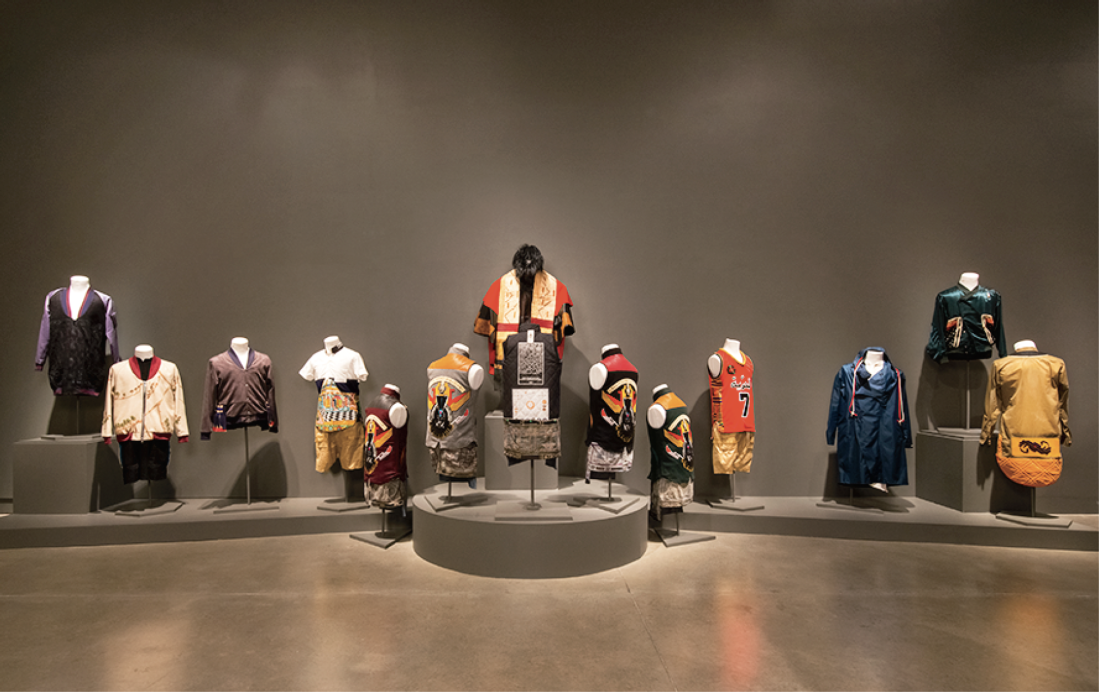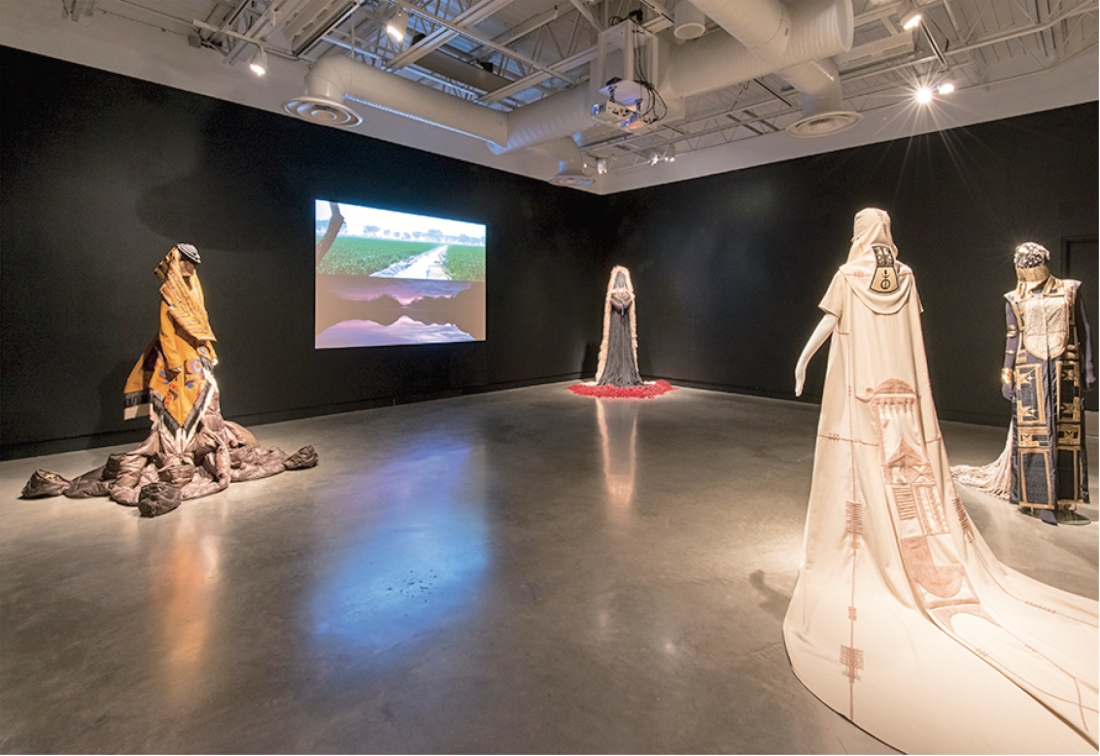Nep Sidhu
Nep Sidhu’s show at the Surrey Art Gallery encompassed an array of cross-cultural references, hybrid spiritual expressions and idealistic collaborations. The Toronto artist, born in London, England and raised in Scarborough, Ontario, has worked with Ishmael Butler of the Seattle-based experimental hip-hop group Shabazz Palaces, Maikoiyo Alley-Barnes of the largely Afro-American creative collective The Black Constellation and Tlingit/Unangax artist Nicholas Galanin, from Alaska. A number of references in the show seem to be to Islam, and the exhibition’s subtitle, “Shadows in the Major Seventh,” references the number seven, which is of considerable significance in the Qur’an. Sidhu’s family background, however, is Punjabi Sikh, which he credits with instilling in him a sense of community and veneration for family and ancestors. India is a rich source of cultural and material references in his work and Sikhism seems to inform his striving to create, as he writes in his exhibition statement, “a connection to the divine through protection, balance and ornament.” Certainly, the idea of ceremonial adornment plays a large part in his art-making, which ranges across forms and disciplines. The exhibition included a line of clothing designed for his fellow artists, poets and musicians; architectonic structures in which elaborate metal frames surround panels of Arabic calligraphy; a trio of large prayer rugs honouring the African-American activist Malcolm X; mixed-media wall-hangings memorializing Sidhu’s late mother and brother; and a complex textile and video installation created in collaboration with Galanin.

Nep Sidhu, Collection of Paradise Sportif, 2013–present, various materials. All photographs: Scott Massey. Courtesy the artist, the Black Constellation collective and the Surrey Art Gallery.
Sidhu has worked as a welder and likens his ready transition from sculpture to sewn articles or “vestments” as a function of the welder’s knowledge of seams, joins and pattern pieces. The visitor was introduced to his wearable art through an impressive array of the Paradise Sportif Collection, inspired by and intended to be worn by members of Shabazz Palaces and The Black Constellation. In this ongoing series, American-style sportswear, such as basketball jerseys, team jackets and quilted vests, has been mated to a range of South Asian fabrics, clothing styles and decorative elements, including embroidery, appliqué and chenille. A particularly handsome example is a black leather motorcycle vest adorned with panels of Rajasthani mirror-work embroidery and emblazoned with the geometric-calligraphic-numerical symbol of The Black Constellation. Another garment, a quilted vest, bears a text panel describing, in Alley-Barnes’s words, what The Black Constellation is. (Among other things, it is “a unified cross disciplinary guild of Soothsayers, Makers, Empaths and Channels…”) Although the Paradise Sportif garments bear professional-looking labels, and although, too, the series title includes the high-fashion term “collection,” they are not a commercial line of clothing. This poses an odd note of exclusivity in the sense of being made for and identified with a very particular group or fraternity rather than with one of Sidhu’s stated ideals, that of “universal brotherhood and sisterhood within our shared soul.” Still, we understand that each piece is extremely labour intensive, precluding large-scale production. We also appreciate that exhibiting the work in a public gallery setting provides a broader form of access, although one that is visual rather than experiential. And again, it seems that Sidhu sees these garments as culturally and spiritually meaningful adornment rather than mere costume.

Nep Sidhu with Nicholas Galanin, No Pigs in Paradise, 2015–2016.
Commissioned by the Frye Art Museum in Seattle, Sidhu’s trio of monumental, Malcolm X-inspired tapestries, Malcolm’s Smile, was hung from the ceiling in a triangular configuration, so that the visitor could walk into the space they created as if into a place of worship. Semi-abstract shapes are suggestive of temples and ziggurats, seen here in combination with embroidered and handwritten texts executed in kufic, an early form of Arabic calligraphy. The tapestries themselves are extremely handsome, although their message is somewhat confused by the seven macramé forms depicting women’s torsos and hanging from the bottom of each of them. These headless, limbless figures might represent “the divine feminine” or perhaps an ideal of gender equality in parallel with an ideal of racial equality. Unfortunately, they resemble women’s vintage bathing suits or, worse still, corsets, and do nothing to clarify Malcolm X’s (controversial) attitude towards women.
In the SAG’s main gallery, Malcolm’s Smile particularly and the other exhibited works generally were accompanied by Ishmael Butler’s audio work Ecdysis, which drew the visitor into another realm through its mesmerizing percussive, flute, clarinet and keyboard notes and tones, and its soundscape of honking, whooshing, chiming and (muffled) shouting. In the adjacent smaller gallery, No Pigs in Paradise, Sidhu’s collaborative installation with Galanin was intended to honour “the divine feminine” while also seeking to redress women’s vulnerability to male violence. Playing behind it was Butler’s terrific reinterpretation of Secondo Coro Delle Lavandaie by the Italian composer Roberto De Simone. The soundtrack is a marvel, filled with pounding percussion and a chorus of women’s voices, their tone half furious, half incantatory. Butler’s music pulses another kind of life into Sidhu’s art, boosting its well-intended but sometimes over-determined forms into the sublime fourth dimension. ❚
“Nep Sidhu: Shadows in the Major Seventh” was exhibited at the Surrey Art Gallery from April 9 to June 12, 2016.
Robin Laurence is a Vancouver-based writer, curator and contributing editor to Border Crossings.

